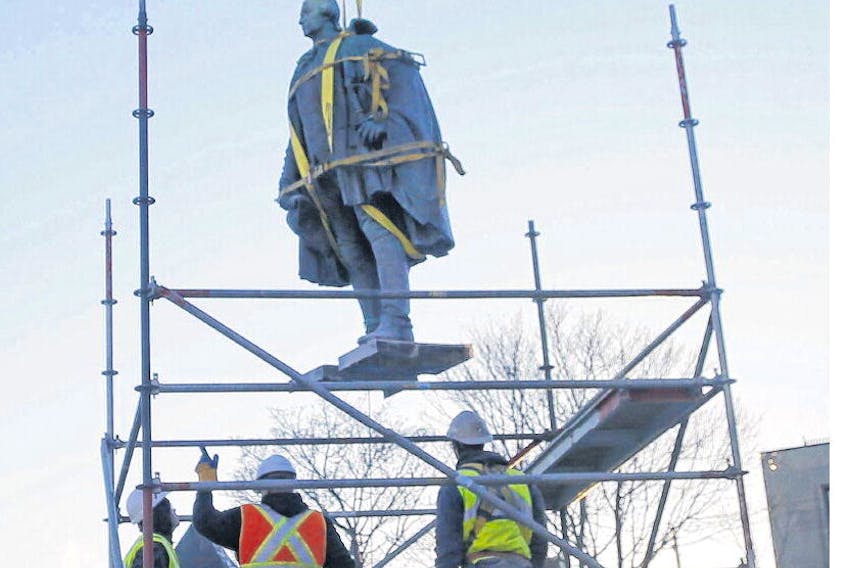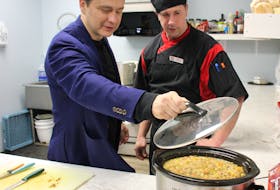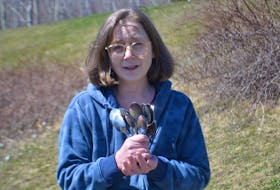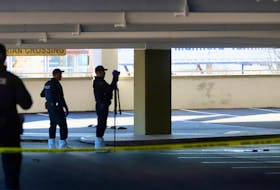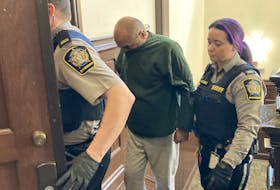Halifax’s founder was knocked off a pedestal Wednesday afternoon.
“I’m kind of disappointed that it took 30 years to do it,” Daniel Paul, a Mi’kmaq historian and author, said of the removal of the statue of Edward Cornwallis from a South End city park.
The 2.75-metre bronze statue, weighing about 1,135 kilograms, was strapped to a truck crane and lifted off its granite base, where it had stood for more than 86 years.
“They will come back within a day or two and remove the pedestal,” said Brendan Elliott, a communications adviser with Halifax Regional Municipality. “There will be no evidence of the statue or pedestal once the work is done.”
Coastal Restoration employees began the work earlierWednesday, erecting a temporary metal fence and scaffolding around the statue in Cornwallis Park, across from the Westin Nova Scotian.
“They will be transporting it (statue) to an undisclosed municipal location,” Elliott said. “We are not releasing the specific location due to concerns that if someone knew where it was, people that may have a desire to deface it would have an easier attempt at it.”
Halifax regional council voted 12-4 Tuesday to immediately remove the statue and place it in temporary storage until a decision is reached on what to do with it in the long term.
Heralded as a great leader by some, the controversial Cornwallis has been denigrated by others for putting a mid-1700s bounty on the lives of Mi’kmaw men, women and children in an effort to
drive them off mainland Nova Scotia.
“It was a statement of white supremacist thinking,” Paul, the author of We Were Not The Savages, said of the monument. “It was like a thumb in the eye. Civilized society does not idolize people who have committed what today would be considered crimes against humanity. To me it was a slap in the face of the Mi’kmaq.”
Still, Tuesday’s council debate often came back to a process that was abandoned. Council had decided in October that a committee would be struck to come back with recommendations about how to deal with the Cornwallis legacy and how to recognize the Indigenous history and culture in the city. But no one has been appointed to the advisory committee and the Assembly of Nova Scotia Mi’kmaq Chiefs said last week that it was frustrated with how long the process was taking. The chiefs demanded that the statue be removed immediately.
Council voted to make it happen.
“As a society and as a longtime resident of Halifax I was hoping that the process that council had put in place would continue simply because this would allow all parties, all positions and different points of view to be looked at,” said Les Canfield, a member of the Halifax Military Heritage Preservation Society.
“The process would encourage broad community engagement, which is what I think is needed to put the Cornwallis issue in proper perspective.”
Canfield said he hopes council and the Mi’kmaq chiefs come to an understanding about the necessity of an advisory panel that could engage the community.
“My personal preference would have been that the statue remain as is, where is, while the process, the special advisory committee process, was underway. The committee would then have an opportunity to present its findings to council and at that stage council would make a decision whether the statue remains as is, where is, or that it should be moved.”
Canfield said the committee’s mandate would be twofold.
“It’s not just how to commemorate Cornwallis. It’s also recommendations as to how to recognize the Indigenous history and culture in HRM.”
Canfield said he hopes the statue is not storedindefinitely, that there is a plan for it. Canfield said it has to be determined how Cornwallis would be
recognized in future and he piggybacked on an idea expounded by a group of junior high school students in Port Williams. The students suggested that Cornwallis take his place among a representative group of the founders of the city and province, including Mi’kmaq, Acadian, African Nova Scotians and others.
Paul could live with Cornwallis being memorialized in a museum setting.
“They could put (information) panels around it but they also should speak to the atrocities the man and his troops committed in Scotland in the Jacobite Rebellion of 1745 and the scalp proclamation,” Paul said. “Cornwallis issued the (scalp) proclamation on Oct. 2, 1749. In June of 1750, they upped the bounty to 50 pounds per scalp.”
Paul said the statue was a major obstacle to reconciliation initiatives.
“Removing it indicates recognition that HRM council has recognized that the Mi’kmaq are people of equal importance to themselves and that’s a positive sign.”
The Cornwallis name still marks the park and a city street.
“When the advisory committee is struck, that committee will address the issue of Cornwallis Park and Cornwallis Street and any other assets in the municipality that have Cornwallis attached to them,” Elliott said.
The Cornwallis statue, depicting the city founder in flowing cape, spurs and high leather boots, was unveiled on June 22, 1931, to mark the 182nd anniversary of the birth of the city. Paul is relieved that it’s gone.
“I turn 80 this year and I was beginning to wonder if this was going to happen before I died,” Paul said. “It got in under the wire, although I hope I’m around for another 10 years or so. To me, it’s a positive step not only for ourselves but for the wider community to open doors to a better understanding among all people.”

